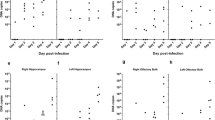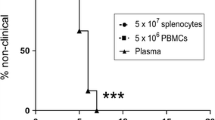Abstract
In this study it has been shown that infection of mother rats by Borna disease virus (BDV) from infected newborns led to a fatal disease. This differed both in clinical symptoms and in histological alterations from the form of the disease which occurred after intracerebral (i.c.) infection. Both parameters were, however, similar to those seen after experimental intranasal (i.n.) infection of adult rats. Detailed immunohistological studies showed clearly that after experimental i.n. infection, the infecting virus migrates intraaxonally from the neuroreceptors in the olfactory epithelium into the brain. It is therefore suggested that i.n. transmission is an important route of natural BDV infection.
Similar content being viewed by others
References
Amsterdam JD, Winokur A, Dyson W, Herzog S, Gonzales F, Rott R, Koprowski H (1985) Borna disease virus: A possible etiologic factor in human affective disorders? Arch Gen Psychiatry 42:1093–1096
Bechter K, Herzog S, Fleischer B, Schüttler R, Rott R (1987) Kernspintomographische Befunde bei psychiatrischen Patienten mit und ohne Serumantikörper gegen das Virus der Borna'schen Krankheit. Nervenarzt 58:617–624
Carbone KM, Duchala CS, Griffin JW, Kincaid AL, Narayan O (1987) Pathogenesis of Borna disease in rats: Evidence that intraaxonal spread is the major route for virus dissemination and determinant for disease incubation. J Virol (in press)
Gosztonyi G, Ludwig H (1984) Neurotransmitter receptors and viral neurotropism. Neuropsychiatr Clin 3:107–114
Haas B, Becht H, Rott R (1986) Purification and properties of an intranuclear virus-specific antigen from tissue infected with Borna disease virus. J Gen Virol 67:235–241
Halasz N, Shepherd GM (1983) Neurochemistry of the vertebrate olfactory bulb. Neurosci 10:759–619
Heinig A (1969) Die Bornasche Krankheit der Pferde und Schafe. In: Röhrer H (ed) Handbuch der Virusinfektionen bei Tieren. Fischer, Jena, vol 4:83–148
Herzog S, Rott R (1980) Replication of Borna disease virus in cell cultures. Med Microbiol Immunol 168:153–158
Herzog S, Kompter C, Frese K, Rott R (1984) Replication of Borna disease virus in rat: age dependent differences in tissue distribution. Med Microbiol Immunol 173:171–177
Hirano N, Kao M, Ludwig H (1983) Persistent, tolerant or subacute infections in Borna disease virus-infected rats. J Gen Virol 64:1521–1530
Joest E, Degen K (1911) Untersuchungen über die pathologische Histologie, Pathogenese und postmortale Diagnose der seuchenhaften Gehirn-Rückenmarksentzündung (Bornasche Krankheit) des Pferdes. Z Inf Krkh Haust 9:1–98
Johnson RT, Mims CA (1968) Pathogenesis of viral infections of the nervous system. N Engl J Med 278:23–30, 84–92
Kaluza G, Lell G, Reinacher M, Stitz L, Willems WR (1987) Neurogenic spread of Semliki forest virus in mice. Arch Virol 93:97–110
Kompter C (1987) Untersuchungen zur Pathogenese der experimentellen Infektion mit dem Virus der Bornaschen Krankheit bei der adulten Lewis-Ratte. Vet Med Diss Gießen, FRG
Krey H, Ludwig H, Rott R (1979) Spread of infectious virus along the optic nerve into the retina in Borna disease virus infected rabbits. Arch Virol 61:283–288
Macrides F, Davis BJ (1983) The olfactory bulb. In: Emson PC (ed) Chemical neuroanatomy. Raven Press, New York, pp 391–426
Matthias D (1954) Der Nachweis von latent infizierten Pferden, Schafen, Rindern und deren Bedeutung als Virusreservoir bei der Bornaschen Krankheit. Arch Exp Vet Med 8:506–511
Matthias D (1958) Weitere Untersuchungen zur Bornaschen Krankheit der Pferde und Schafe. Arch Exp Vet Med 12:920–947
Monath TP, Cropp B, Harrison AK (1983) Mode of entry of a neurotropic arbovirus into the central nervous system. Lab Invest 48:399–410
Narayan O, Herzog S, Frese K, Scheefers H, Rott R (1983a) Pathogenesis of Borna disease in rats: Immune-mediated viral ophthalmoencephalopathy causing blindness and behavioral abnormalities. J Infect Dis 148:305–315
Narayan O, Herzog S, Frese K, Scheefers H, Rott R (1983b) Behavioral disease in rats caused by immunopathological responses to persistent Borna virus in the brain. Science 220:1401–1402
Nitzschke E (1963) Untersuchungen über die experimentelle Borna-Virus-Infektion bei der Ratte. Zentralbl Veterinärmed [B] 10:470–527
Paxinos G, Watson C (1982) The rat brain in stereotaxic coordinates. Academic Press, Sidney
Reinacher M, Bonin J, Narayan O, Scholtissek C (1983) Pathogenesis of neurovirulent influenza A virus infection in mice: route of entry of virus into brain determines infection of different populations of cells. Lab Invest 49:686–692
Rott R, Herzog S, Fleischer B, Winokur A, Amsterdam J, Dyson W, Koprowski H (1985) Detection of serum antibodies to Borna disease virus in patients with psychiatric disorders. Science 228:755–756
Switzer RC, de Olmos J, Heiner L (1985) Olfactory system. In: Paxinos G (ed) The rat nervous system. Academic Press, vol 1, Sydney, pp 1–36
Tomlinson AH, Esiri MM (1983) Herpes simplex encephalitis-immunohistological demonstration of spread of virus via olfactory pathways in mice. J Neurol Sci 60:473–484
Zilles K (1985) The vortex of the rat. A stereotaxic atlas. Springer, Berlin Heidelberg New York
Zwick W (1939) Bornasche Krankheit und Enzephalomyelitis der Tiere. In: Gildemeister E, Haagen E, Waldmann O (eds) Handbuch der Viruskrankheiten, vol 2. Fischer, Jena, pp 252–294
Author information
Authors and Affiliations
Additional information
Recipient of a scholarship by Deutscher Akademischer Austauschdienst (DAAD)
Rights and permissions
About this article
Cite this article
Morales, J.A., Herzog, S., Kompter, C. et al. Axonal transport of Borna disease virus along olfactory pathways in spontaneously and experimentally infected rats. Med Microbiol Immunol 177, 51–68 (1988). https://doi.org/10.1007/BF00189527
Received:
Issue Date:
DOI: https://doi.org/10.1007/BF00189527




